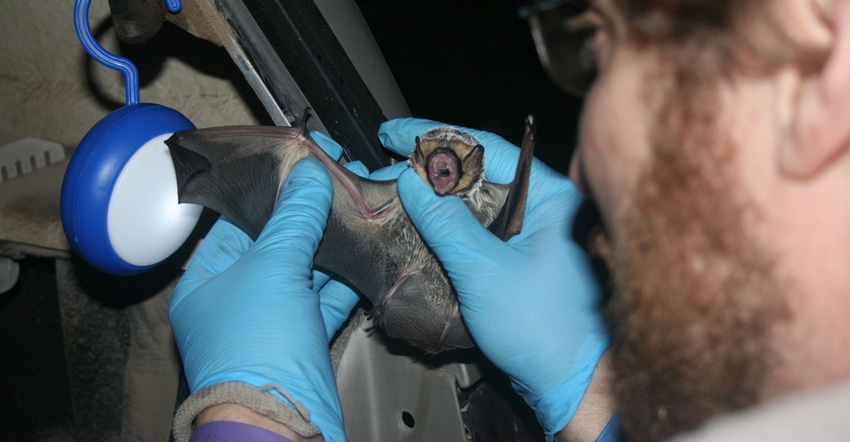
White-nose syndrome, a fungal disease that negatively affects hibernating bats, was confirmed in Nebraska during a recent survey of a mine in Cass County. The U.S. Geological Survey's National Wildlife Health Center, based in Madison, Wis., confirmed WNS in a little brown bat, a northern long-eared bat and a tri-colored bat from the mine.
The disease, now found in 30 states and five Canadian provinces, could prove devastating to Nebraska hibernating bat populations, and in turn have an impact on agriculture in the state. "As a natural pest control, bats reduce the amount of inputs required in farm fields and helps save farmers money," says Michael Whitby, a University of Nebraska PhD student working on bat research. "A single big brown bat, which is the most common species in agricultural areas of Nebraska, eats nearly 100 insects every night, primarily agricultural pests," he explains. "A colony of about 150 bats can eat almost a million cucumber beetles a year, preventing over 33 million rootworms from being produced. A recent study found that the reduction of rootworms also limits the spread of fungal disease and increases corn crop yields by at least $1 billion globally."
Effect on bat populations
There are 11 different bat species in Nebraska. The eastern part of the state has eight species, while the Panhandle has up to 10. Two additional species have been found in the state, but there are no known populations of them, so it is likely they are bats that got lost during dispersal or migration, Whitby says.
"Bat populations that hibernate in caves during the winter are expected to see population declines due to WNS of over 90% within the first two to three years," Whitby says. "The tricolored bat, little brown bat and northern long-eared bat will be the first ones affected," he says. "Three more species could be affected when it reaches the western part of the state." Three species that migrate and do not hibernate will likely not be affected by WNS.

LOOKING FOR BATS: Whitby has several bat research project sites — including bat detectors like those pictured here — located on farms and ranches in east-central Nebraska.

The confirmation of WNS in the state was expected. According to Nebraska Game and Parks Commission officials, the fungus that causes the disease was first detected in the state in 2015 in another mine in Cass County. It was detected in 2016 on bats sampled from a Sarpy County mine. WNS affects bats during hibernation, causing them to awaken more often and use up fat reserves they need to survive through the winter. This occurrence can cause bats to emerge prematurely from hibernation too early in the season, and perhaps starve or freeze to death.
How to help
That is why studying bats in the state is so crucial. "Our bat team currently has three projects that conduct bat surveys across the state and all rely on the generosity of Nebraskans, especially farmers and ranchers," Whitby says. "For example, I have 16 bat detectors on the top of silos and grain legs in east-central Nebraska. My colleagues have conducted statewide surveys the past two years and have been given permission to survey over 500 properties." According to Whitby, the Cooperative Fish and Wildlife Research Unit at UNL has several projects examining the benefits of bats to agriculture, looking specifically at what bats eat in agricultural areas, what habitats they use and population trends.
"The primary way to stop the spread of WNS is by reducing disturbance in caves and mines and using decontamination procedures if you have to enter them," Whitby says. "Healthy forests support many bat populations. Using and promoting practices that support forest and land health promotes healthy bat populations." Removing trees also removes roosting and foraging opportunities for many species, especially those that forage primarily in forest habitats.
He suggests installing bat boxes on rural properties to attract bat colonies and provide a safe area for reproduction. "Additionally, farmers and ranchers can use cattle tanks with wildlife ladders, to help bats and other wildlife avoid drowning in the tanks," Whitby says.
You can learn more by contacting Whitby at [email protected].
About the Author(s)
You May Also Like






